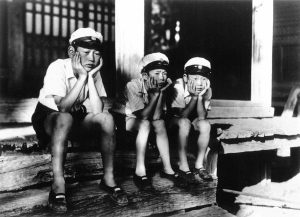This month the Japan Society will be holding an event to showcase the films of one of the forgotten masters of Japanese cinema, Hiroshi Shimizu. Overshadowed in the west compared to his contemporaries Yasujiro Ozu and Kenji Mizoguchi, Shimizu has over 160 films under his belt over a 35-year-career that spanned the silent era into the golden age of Japanese cinema. A common theme in his films were his portrayals of those excluded from mainstream Japanese society. This could include migrant workers, war veterans, children, people with disabilities, and ‘fallen women’. Often shot on location and casted by non-actors, each of these films possess the full essence of humanity with elegance and compassion. Shimizu’s unique style and technique of filmmaking involve constant tracking shots, as he allows the camera to glide alongside characters doing everyday actions. The camera never interferes with the characters, but always remains just an observer. It reminds the viewers that life is transient and people or objects will fade out from view, but life will go on in other ways. In this article, I will list some of the films that I believe are a great place to start for those who are interested in Shimizu’s filmography.
Note: Most of the films listed will be from Shimizu’s years under Shochiku studio since they are more easily accessible. Japan Society will be screening movies for his more rare and harder to find films from the postwar part of his career starting on Friday May 16, 2024. Get your tickets here.
Mr. Thank You (1936)

An enchanting road movie that is nothing short of pleasant and sweet, and reminds one of the importance of community. The plot follows a local bus driver (played by Ken Uehara) on his everyday route as he transports a group of travelers (who represent Japanese society in a period of economic and social depression) from the Izu peninsula to the train station that links it to Tokyo. Simple and very effective.
Children of the Beehive (1948)

The first film from the “Beehive trilogy”. Another simple story about war orphans, with a road movie spirit with a neorealist approach. This tender and kind study of childhood during unfortunate circumstances and how they overcome fate in hard times established Shimizu as a children’s director. “Children of the Beehive” is followed by Children of the Beehive: What Happened Next (1951) and Children of the Great Buddha (1952).
Ornamental Hairpin (1941)

Another Shimizu film that can best be described as deceptively simple and quiet on the surface, but deeply existential when pulled apart. Shot on location in an inn surrounded by forests and hotsprings, the plot tells a story of forming bonds with strangers and creating blissful memories that can only exist during that season. With an abundance of characters we meet the grouchy professor (Tatsuo Saito), a newly married couple, a grandfather with his two younger grandsons, Nanmura (Chishu Ryu), a soldier who is injured when he steps on the titular ornamental hairpin, and Miss Emi (Kinuyo Tanaka) the owner of the hairpin who came to the inn to escape the bustling city.
Japanese Girls at the Harbor (1933)

One of Shimizu’s more accessible silent films, this melodrama follows two friends who find themselves involved in a love triangle after meeting a boy. A series of accidents will cause their lives to separate but still bound to reunite by fate. Whether or not their friendship can ever go back to being the same remains the question. Shimizu manages to execute all of these plot twists in just over an hour with innovative camera angles.
The Masseurs and a Woman (1938)

At this point, Shimizu had moved away from studio shooting and preferred the freedom that came with on location filming. What he created was a tender yet profound approach to the pains of the temporaries of life and the need for human connection. In the remote resort in the mountains, we meet our main characters consisting of a pair of blind masseurs, a mysterious city woman, and a lonely man with his ill-behaved nephew. ‘The Masseurs and a Woman’ sees Shimizu experimenting with comedy creating a relaxing atmosphere where the audience feels like they’re getting the spa treatment too.
Where to watch: Availability of Shimizu’s catalogue remains less accessible than his contemporaries, but all 5 films are available on Criterion Channel for readers living in US or Canada, and most have been uploaded to YouTube with English subtitles by various users.



















